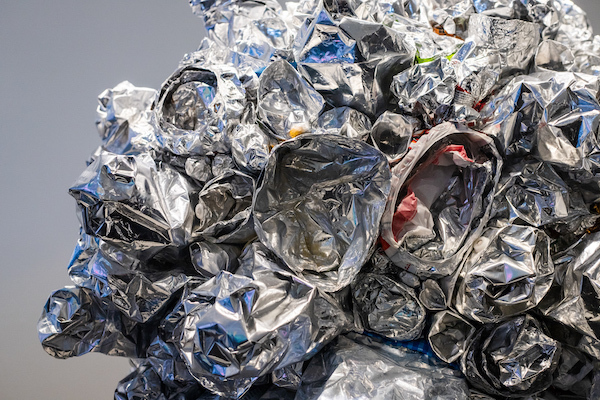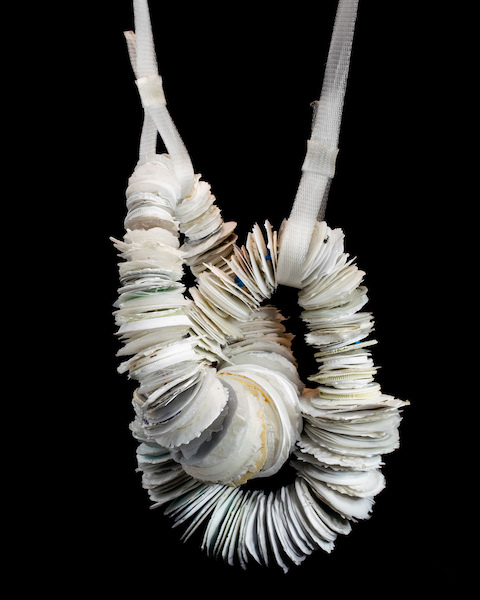Hidden In Plain Sight: Magnifying What Is Already There
Review of Hidden in Plain Sight by Maria Phillips at Bellevue Arts Museum.
Written by TeenTix Newsroom Writer Sumeya Block and edited by Teen Editor Olivia Sun.

Maria Phillips’ exhibit Hidden In Plain Sight at the Bellevue Arts Museum is not only a wake up call to the harm of plastic consumption in Seattle and the impact it has on our oceans, but a reminder to fight our society’s complacency. What started as a passion project for Phillips’ family, Hidden In Plain Sight grew into a series of sculptures that evoke a prudent message, if not a warning, for those who listen: human trash is taking over our planet. After all, the sheer amount of plastic tins, toothbrushes, rags, and food cartons collected by Phillips within a single year has the capacity to fill the large exhibit rooms.
There are many famous artists who have reused items to allude to an issue in their community, but Phillips has a distinct style across all her pieces. Let’s call it the looking glass effect. Phillips draws the viewer's eye to every aspect of trash before them. From the Calvin Klein label on a half open box, which once held clothes, to the remaining stains of food on an old food carton, I notice that Phillips does not choose to sanitize these reused items: rather, she calls attention to them. By commanding awareness to the ugly brown stain on a crumpled bag of chips and the rolled up lint on an old rag, Phillips places the blame on us, the viewers, and the corporations who mass produce the plastic products we love so much.

The somber setting of each work takes us through a world that feels familiar. The choice of complete silence leaves Phillips’ viewers with a feeling of desolation and disconnect from the rest of the museum. One piece titled Technosphere reinforces this feeling. Phillips says she chose the name Technosphere because it means the remains of man-made objects. It is a globe, made from inverted chip bags, that slowly revolves along an axis, allowing viewers to see every inch of it. This possible planet earth is covered in plastic and foil, as if life is being suffocated by pollution. It feels as if just the viewer and the polluted globe are left. Technosphere is Phillips’ representation of the world that we’ve made for ourselves. The globe feels abandoned and disheartened by what it has become. I wonder what it looked like before—if it was ever something other than plastic, or if it has always been covered in man-made remains.
But what is perhaps most notable yet most frightening about Hidden In Plain Sight is the sculpture Undercurrent: Plasticene. Spanning about fifty feet long and twenty feet tall, the work is a quilt made of hundreds of chip bags, trash bags, and napkins. Undercurrent: Plasticene is not only large, but sturdy: so sturdy in fact it feels like shelter. It is a shelter built to protect us from our own environmental consequences—a way of obscuring what we have really done by blurring our vision. Through the sculpture, Phillips comments how trash, something that should have a negative connotation, has become so familiar that it’s like home. For example, all of the plastic in the quilt is formed like ocean waves, as if trash has become a part of our natural world. Viewers are able to walk under this shelter and observe the trash that makes up the artwork. Even the names of products that are generally considered planet-friendly or health-conscious—like organic chickpea puffs or veggie sticks—are on display. All these plastics are layered over each other, building a fort that protects us from the outside. It is ironic that the quilt feels more natural than anything else in the room. In our society, pollution has become so normalized that it is no longer something that is out of place. It has been accepted by the world and thus commands the center stage.

Maria Phillips zooms in on what society chooses to ignore. Her work does not discuss a hypothetical future, but now. Walking through this exhibit, I feel like I myself am in her piece Technosphere, trash everywhere I turn and plastic festering and seeping through every room. Hidden in Plain Sight it is not just an art installation. It is our own world...you just have to look.
Lead photo caption: Maria Phillips' Undercurrent: Plasticene. Photo courtesy of Bellevue Arts Museum.
The TeenTix Newsroom is a group of teen writers led by the Teen Editorial Staff. For each review, Newsroom writers work individually with a teen editor to polish their writing for publication. The Teen Editorial Staff is made up of 6 teens who curate the review portion of the TeenTix blog. More information about the Teen Editorial Staff can be found HERE.
The TeenTix Press Corps promotes critical thinking, communication, and information literacy through criticism and journalism practice for teens. For more information about the Press Corps program see HERE.

